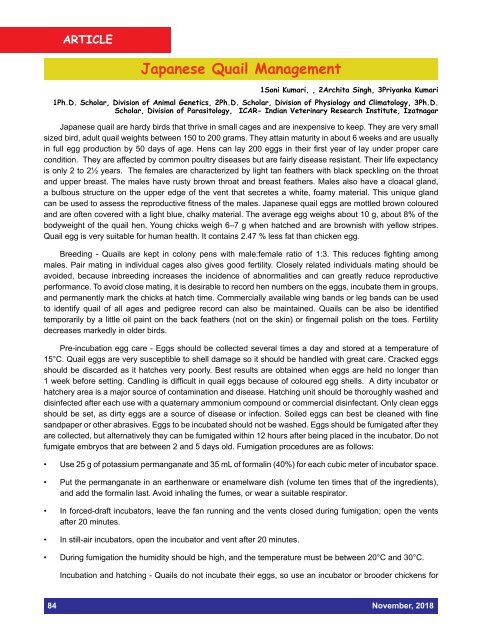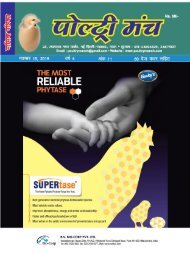November 2018 Punch PDF
You also want an ePaper? Increase the reach of your titles
YUMPU automatically turns print PDFs into web optimized ePapers that Google loves.
ARTICLE<br />
Japanese Quail Management<br />
1Soni Kumari, , 2Archita Singh, 3Priyanka Kumari<br />
1Ph.D. Scholar, Division of Animal Genetics, 2Ph.D. Scholar, Division of Physiology and Climatology, 3Ph.D.<br />
Scholar, Division of Parasitology, ICAR- Indian Veterinary Research Institute, Izatnagar<br />
Japanese quail are hardy birds that thrive in small cages and are inexpensive to keep. They are very small<br />
sized bird, adult quail weights between 150 to 200 grams. They attain maturity in about 6 weeks and are usually<br />
in full egg production by 50 days of age. Hens can lay 200 eggs in their first year of lay under proper care<br />
condition. They are affected by common poultry diseases but are fairly disease resistant. Their life expectancy<br />
is only 2 to 2½ years. The females are characterized by light tan feathers with black speckling on the throat<br />
and upper breast. The males have rusty brown throat and breast feathers. Males also have a cloacal gland,<br />
a bulbous structure on the upper edge of the vent that secretes a white, foamy material. This unique gland<br />
can be used to assess the reproductive fitness of the males. Japanese quail eggs are mottled brown coloured<br />
and are often covered with a light blue, chalky material. The average egg weighs about 10 g, about 8% of the<br />
bodyweight of the quail hen. Young chicks weigh 6–7 g when hatched and are brownish with yellow stripes.<br />
Quail egg is very suitable for human health. It contains 2.47 % less fat than chicken egg.<br />
Breeding - Quails are kept in colony pens with male:female ratio of 1:3. This reduces fighting among<br />
males. Pair mating in individual cages also gives good fertility. Closely related individuals mating should be<br />
avoided, because inbreeding increases the incidence of abnormalities and can greatly reduce reproductive<br />
performance. To avoid close mating, it is desirable to record hen numbers on the eggs, incubate them in groups,<br />
and permanently mark the chicks at hatch time. Commercially available wing bands or leg bands can be used<br />
to identify quail of all ages and pedigree record can also be maintained. Quails can be also be identified<br />
temporarily by a little oil paint on the back feathers (not on the skin) or fingernail polish on the toes. Fertility<br />
decreases markedly in older birds.<br />
Pre-incubation egg care - Eggs should be collected several times a day and stored at a temperature of<br />
15°C. Quail eggs are very susceptible to shell damage so it should be handled with great care. Cracked eggs<br />
should be discarded as it hatches very poorly. Best results are obtained when eggs are held no longer than<br />
1 week before setting. Candling is difficult in quail eggs because of coloured egg shells. A dirty incubator or<br />
hatchery area is a major source of contamination and disease. Hatching unit should be thoroughly washed and<br />
disinfected after each use with a quaternary ammonium compound or commercial disinfectant. Only clean eggs<br />
should be set, as dirty eggs are a source of disease or infection. Soiled eggs can best be cleaned with fine<br />
sandpaper or other abrasives. Eggs to be incubated should not be washed. Eggs should be fumigated after they<br />
are collected, but alternatively they can be fumigated within 12 hours after being placed in the incubator. Do not<br />
fumigate embryos that are between 2 and 5 days old. Fumigation procedures are as follows:<br />
• Use 25 g of potassium permanganate and 35 mL of formalin (40%) for each cubic meter of incubator space.<br />
• Put the permanganate in an earthenware or enamelware dish (volume ten times that of the ingredients),<br />
and add the formalin last. Avoid inhaling the fumes, or wear a suitable respirator.<br />
• In forced-draft incubators, leave the fan running and the vents closed during fumigation; open the vents<br />
after 20 minutes.<br />
• In still-air incubators, open the incubator and vent after 20 minutes.<br />
• During fumigation the humidity should be high, and the temperature must be between 20°C and 30°C.<br />
Incubation and hatching - Quails do not incubate their eggs, so use an incubator or brooder chickens for<br />
84 <strong>November</strong>, <strong>2018</strong>





